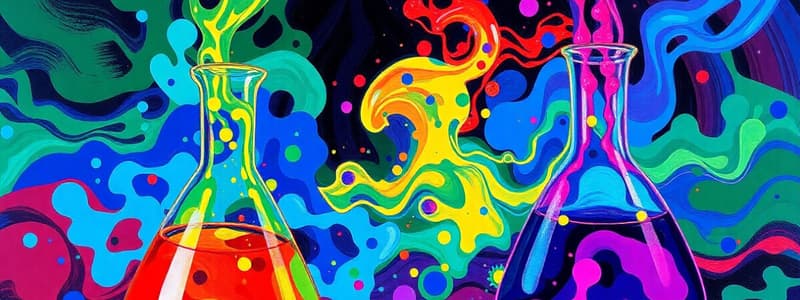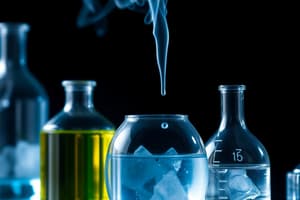Podcast
Questions and Answers
What is the definition of energy in a chemical context?
What is the definition of energy in a chemical context?
- The capacity to do work (correct)
- The capacity to conserve heat
- The potential for objects to maintain position
- The speed at which reactions occur
Which type of energy is associated with the random motion of atoms and molecules?
Which type of energy is associated with the random motion of atoms and molecules?
- Kinetic Energy
- Potential Energy
- Radiant Energy
- Thermal Energy (correct)
What is the First Law of Thermodynamics commonly known as?
What is the First Law of Thermodynamics commonly known as?
- Law of energy transformation
- Law of conservation of mass
- Law of natural processes
- Law of conservation of energy (correct)
In an exothermic reaction, how do the bonds in the products compare to those in the reactants?
In an exothermic reaction, how do the bonds in the products compare to those in the reactants?
What characterizes a nonspontaneous process?
What characterizes a nonspontaneous process?
What type of system can exchange both mass and energy with its surroundings?
What type of system can exchange both mass and energy with its surroundings?
What is thermochemistry primarily concerned with?
What is thermochemistry primarily concerned with?
Which statement about energy changes in chemical reactions is true?
Which statement about energy changes in chemical reactions is true?
What type of process occurs when heat is absorbed by the system from the surroundings?
What type of process occurs when heat is absorbed by the system from the surroundings?
Which of the following statements best describes a closed system?
Which of the following statements best describes a closed system?
For work done during expansion against a vacuum, what is the value of work (w)?
For work done during expansion against a vacuum, what is the value of work (w)?
According to the first law of thermodynamics, what is the relationship between change in energy, heat, and work?
According to the first law of thermodynamics, what is the relationship between change in energy, heat, and work?
What happens to energy in an isolated system?
What happens to energy in an isolated system?
What is the effect of performing work on a system at constant volume?
What is the effect of performing work on a system at constant volume?
When a gas expands from 2.0 L to 6.0 L at a pressure of 1.2 atm, what is the work done by the gas?
When a gas expands from 2.0 L to 6.0 L at a pressure of 1.2 atm, what is the work done by the gas?
What is the implication of the law of conservation of energy in thermodynamics?
What is the implication of the law of conservation of energy in thermodynamics?
What does the equation ∆E = q + P∆V represent in a constant pressure process?
What does the equation ∆E = q + P∆V represent in a constant pressure process?
Under which condition is the enthalpy change equal to the heat change?
Under which condition is the enthalpy change equal to the heat change?
How is the enthalpy change for an exothermic reaction characterized?
How is the enthalpy change for an exothermic reaction characterized?
If the enthalpy change ∆H for melting ice is 6.01 kJ/mol, what type of process is this?
If the enthalpy change ∆H for melting ice is 6.01 kJ/mol, what type of process is this?
What does the term standard heat of formation refer to?
What does the term standard heat of formation refer to?
The equation ∆H = ∆E + P∆V holds true under which circumstances?
The equation ∆H = ∆E + P∆V holds true under which circumstances?
In the reaction Zn(s) + Cu²⁺(aq) → Zn²⁺(aq) + Cu(s), how is the enthalpy change represented?
In the reaction Zn(s) + Cu²⁺(aq) → Zn²⁺(aq) + Cu(s), how is the enthalpy change represented?
What is the relationship between ΔH and PΔV in a constant pressure process?
What is the relationship between ΔH and PΔV in a constant pressure process?
What is the standard enthalpy of formation for any element in its most stable state?
What is the standard enthalpy of formation for any element in its most stable state?
Which method can be used to determine the enthalpy change when direct synthesis from elements is not feasible?
Which method can be used to determine the enthalpy change when direct synthesis from elements is not feasible?
What is the enthalpy change for the reaction of graphite and oxygen to form carbon dioxide?
What is the enthalpy change for the reaction of graphite and oxygen to form carbon dioxide?
In reversing equation (b) where carbon monoxide reacts with oxygen to produce carbon dioxide, what is the sign of the enthalpy change?
In reversing equation (b) where carbon monoxide reacts with oxygen to produce carbon dioxide, what is the sign of the enthalpy change?
What is the correct final enthalpy change for the reaction producing carbon monoxide from graphite and oxygen?
What is the correct final enthalpy change for the reaction producing carbon monoxide from graphite and oxygen?
Why is the indirect approach necessary for certain reactions when determining their enthalpy change?
Why is the indirect approach necessary for certain reactions when determining their enthalpy change?
What is the role of a calorimeter in a laboratory setting?
What is the role of a calorimeter in a laboratory setting?
In Hess's law, how can chemical equations be manipulated?
In Hess's law, how can chemical equations be manipulated?
What is the specific heat of a substance defined as?
What is the specific heat of a substance defined as?
How is the heat capacity (C) of a substance calculated?
How is the heat capacity (C) of a substance calculated?
In a constant-volume calorimeter, what takes place during the measurement of heat of combustion?
In a constant-volume calorimeter, what takes place during the measurement of heat of combustion?
What does the expression $q_{overall} = 0$ indicate in the constant-volume calorimetry setup?
What does the expression $q_{overall} = 0$ indicate in the constant-volume calorimetry setup?
For the calculation in constant-pressure calorimetry, which one of the following statements is true?
For the calculation in constant-pressure calorimetry, which one of the following statements is true?
What does the variable ∆T represent in the heat calculation formulas?
What does the variable ∆T represent in the heat calculation formulas?
Which of the following is NOT a component of the constant-volume calorimeter's operation?
Which of the following is NOT a component of the constant-volume calorimeter's operation?
What formula describes the relationship between q_cal and q_rxn in a calorimeter?
What formula describes the relationship between q_cal and q_rxn in a calorimeter?
What is the enthalpy change (
abla H) for the reaction of magnesium with oxygen to form magnesium oxide?
What is the enthalpy change ( abla H) for the reaction of magnesium with oxygen to form magnesium oxide?
Which of the following is true about changing the physical state of a reactant or product in a thermochemical equation?
Which of the following is true about changing the physical state of a reactant or product in a thermochemical equation?
What happens to the sign of ∆H when a thermochemical equation is reversed?
What happens to the sign of ∆H when a thermochemical equation is reversed?
If the molar mass of SO2 is 64.07 g/mol, how much heat is evolved when 74.6 g of SO2 is converted to SO3?
If the molar mass of SO2 is 64.07 g/mol, how much heat is evolved when 74.6 g of SO2 is converted to SO3?
What is the definition of standard heat of combustion?
What is the definition of standard heat of combustion?
What is the heat of hydrogenation for cyclohexene in relation to benzene?
What is the heat of hydrogenation for cyclohexene in relation to benzene?
What expression correctly represents the enthalpy change for a reaction in terms of standard enthalpies of formation?
What expression correctly represents the enthalpy change for a reaction in terms of standard enthalpies of formation?
Which reaction shows the standard heat of combustion for butane?
Which reaction shows the standard heat of combustion for butane?
In a thermochemical equation, which factor affects the magnitude of ΔH?
In a thermochemical equation, which factor affects the magnitude of ΔH?
Flashcards
Energy
Energy
The ability to do work, and in chemistry, it refers to changes in energy during a process.
Kinetic Energy
Kinetic Energy
Energy associated with the movement of an object.
Thermal Energy
Thermal Energy
Energy associated with random motion of atoms and molecules. It is a measure of the average kinetic energy of the particles in a substance.
Chemical Energy
Chemical Energy
Signup and view all the flashcards
Potential Energy
Potential Energy
Signup and view all the flashcards
First Law of Thermodynamics
First Law of Thermodynamics
Signup and view all the flashcards
Spontaneous Process
Spontaneous Process
Signup and view all the flashcards
Exothermic Reaction
Exothermic Reaction
Signup and view all the flashcards
Closed System
Closed System
Signup and view all the flashcards
Isolated System
Isolated System
Signup and view all the flashcards
Exothermic Process
Exothermic Process
Signup and view all the flashcards
Endothermic Process
Endothermic Process
Signup and view all the flashcards
The Law of Conservation of Energy (1st Law of Thermodynamics)
The Law of Conservation of Energy (1st Law of Thermodynamics)
Signup and view all the flashcards
Mathematical Formulation of the 1st Law of Thermodynamics
Mathematical Formulation of the 1st Law of Thermodynamics
Signup and view all the flashcards
Enthalpy of Chemical Reaction
Enthalpy of Chemical Reaction
Signup and view all the flashcards
Internal Energy Change at Constant Volume
Internal Energy Change at Constant Volume
Signup and view all the flashcards
First Law of Thermodynamics (for a closed system)
First Law of Thermodynamics (for a closed system)
Signup and view all the flashcards
Enthalpy Change (∆H)
Enthalpy Change (∆H)
Signup and view all the flashcards
Enthalpy of Reaction (∆H)
Enthalpy of Reaction (∆H)
Signup and view all the flashcards
Standard Heat of Formation
Standard Heat of Formation
Signup and view all the flashcards
Thermochemical Equation
Thermochemical Equation
Signup and view all the flashcards
Standard State Conditions
Standard State Conditions
Signup and view all the flashcards
Standard Enthalpy of Formation of Elements
Standard Enthalpy of Formation of Elements
Signup and view all the flashcards
Hess's Law
Hess's Law
Signup and view all the flashcards
Enthalpy Change and Steps
Enthalpy Change and Steps
Signup and view all the flashcards
Direct Method of Enthalpy of Formation
Direct Method of Enthalpy of Formation
Signup and view all the flashcards
Indirect Method of Enthalpy of Formation
Indirect Method of Enthalpy of Formation
Signup and view all the flashcards
Calorimetry
Calorimetry
Signup and view all the flashcards
Calorimeter
Calorimeter
Signup and view all the flashcards
Importance of Calorimetry
Importance of Calorimetry
Signup and view all the flashcards
Standard Enthalpy of Formation (∆𝐻𝑓⁰)
Standard Enthalpy of Formation (∆𝐻𝑓⁰)
Signup and view all the flashcards
Standard Heat of Combustion
Standard Heat of Combustion
Signup and view all the flashcards
Heat of Hydrogenation
Heat of Hydrogenation
Signup and view all the flashcards
Standard Enthalpy of Reaction (∆𝐻𝑟𝑥𝑛⁰)
Standard Enthalpy of Reaction (∆𝐻𝑟𝑥𝑛⁰)
Signup and view all the flashcards
Physical State
Physical State
Signup and view all the flashcards
Magnitude of ∆𝐻 is proportional to the amount of products and reactants
Magnitude of ∆𝐻 is proportional to the amount of products and reactants
Signup and view all the flashcards
Multiplying a thermochemical equation by a factor
Multiplying a thermochemical equation by a factor
Signup and view all the flashcards
Reversing a thermochemical equation
Reversing a thermochemical equation
Signup and view all the flashcards
Calculating Standard Enthalpy of Reaction
Calculating Standard Enthalpy of Reaction
Signup and view all the flashcards
Specific Heat
Specific Heat
Signup and view all the flashcards
Heat Capacity
Heat Capacity
Signup and view all the flashcards
Constant-Volume Calorimeter
Constant-Volume Calorimeter
Signup and view all the flashcards
Heat of Combustion
Heat of Combustion
Signup and view all the flashcards
Constant-Pressure Calorimeter
Constant-Pressure Calorimeter
Signup and view all the flashcards
Enthalpy Change
Enthalpy Change
Signup and view all the flashcards
Heat Change of a System
Heat Change of a System
Signup and view all the flashcards
Study Notes
Thermochemistry: Nature and Types of Energy
- Energy is defined as the capacity to do work. Work equals force multiplied by distance.
- Chemists define work as an energy change resulting from a process.
- Kinetic energy is the energy associated with motion. It is one type of energy of particular interest to chemists.
- Other forms of energy include radiant energy (solar energy), thermal energy (random motion of atoms and molecules), chemical energy (stored within chemical substances), and potential energy (energy available due to position).
Energy Changes
- Radiant energy is primarily from the sun, being the earth's primary energy source.
- Thermal energy is related to the random motion of atoms and molecules.
- Chemical energy is stored within substances and released in chemical reactions.
- Potential energy is energy stored because of an object's position.
- The Law of conservation of energy states that when one form of energy disappears, another equal magnitude form of energy appears in its place. This is also known as the first law of thermodynamics.
Spontaneous Processes
- Spontaneous processes occur naturally without external intervention.
- Processes in nature are spontaneous, going in only one direction and are thermodynamically irreversible.
- They can only be reversed with external agency.
Energy Changes in Chemical Reactions
- Almost all chemical reactions absorb or produce energy, often in the form of heat.
- Thermochemistry studies heat changes in chemical reactions.
- These changes are crucial to understanding mass ratios of reactants and products.
- The energy changes' analysis requires defining the system (the focus) and the surroundings (everything else).
Types of Systems
- Open systems can exchange both mass and energy.
- Closed systems can exchange energy (heat) but not matter.
- Isolated systems can exchange neither mass nor energy.
Exothermic and Endothermic Processes
- Exothermic processes release heat to their surroundings (e.g., 2H2(g) + O2(g) → 2H2O(l) + energy)
- Endothermic processes absorb heat from their surroundings (e.g., Energy + 2HgO(s) → 2Hg(l) + O2(g)).
Enthalpy Changes
- Enthalpy (H) is a thermodynamic function related to the internal energy and pressure-volume work of a system.
- Changes in enthalpy (ΔH) represent heat changes at constant pressure.
- If chemical reactions occur at constant volume, ∆E = qν
- At constant pressure, ∆H = qp
Thermochemical Equations and Rules
- A thermochemical equation details a reaction and its enthalpy change.
- Enthalpy changes (ΔH) are directly proportional to the amount of reactants or products.
- When a thermochemical equation is multiplied , the enthalpy change is also multiplied by the same factor.
- Reversing a reaction reverses the sign of the enthalpy change.
Standard Enthalpy of Formation
- Standard enthalpy of formation (ΔHf) is the enthalpy change when one mole of a compound forms from its constituent elements in their standard states (usually 1 atm and 298 K).
Calorimetry
- Calorimetry measures heat changes during physical or chemical processes.
- Specific heat capacity measures how much heat needed to raise 1 gram of substance by 1 degree.
- Constant volume or pressure calorimeters are devices used to precisely measure these changes, often related to combustion or other reactions.
Studying That Suits You
Use AI to generate personalized quizzes and flashcards to suit your learning preferences.




